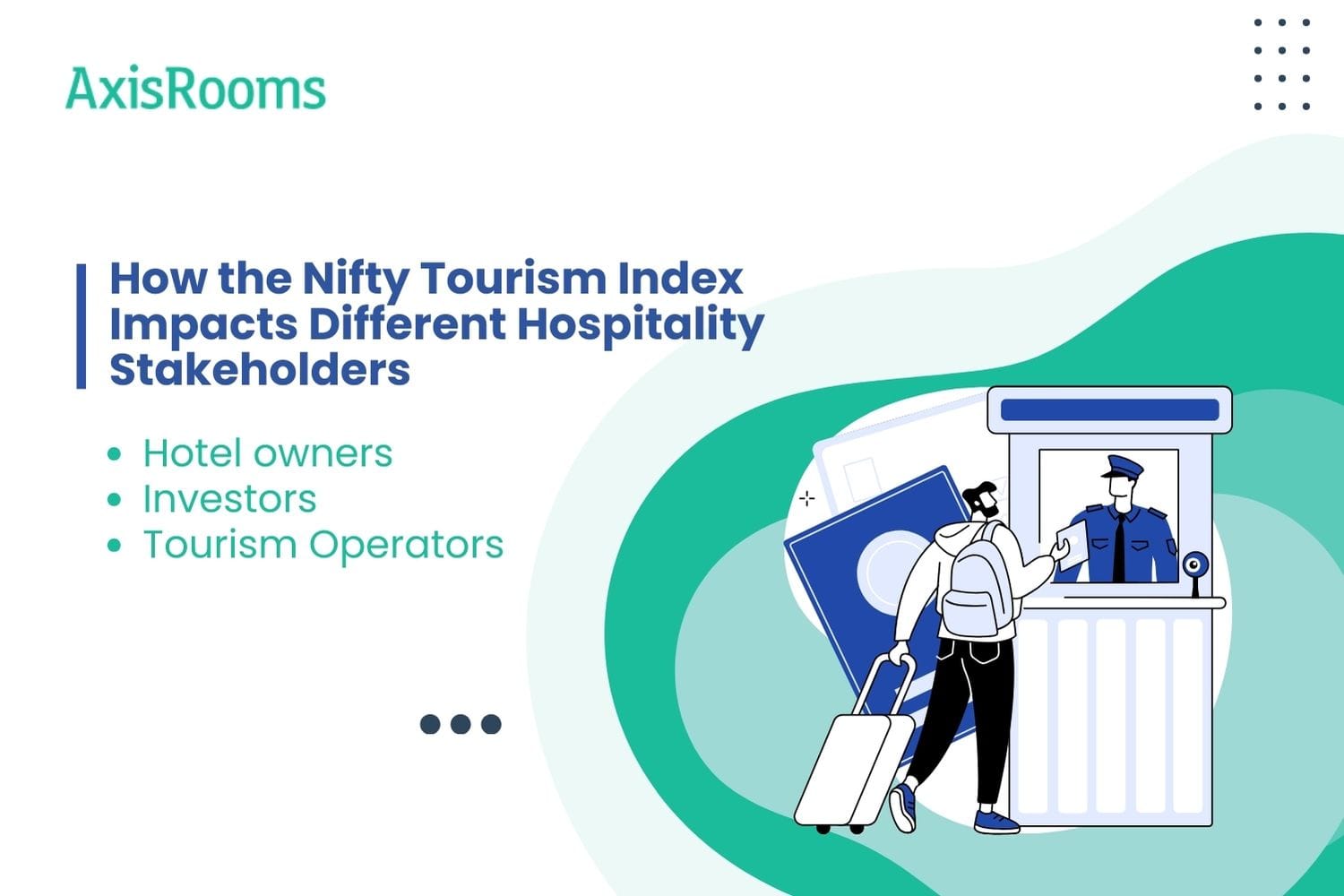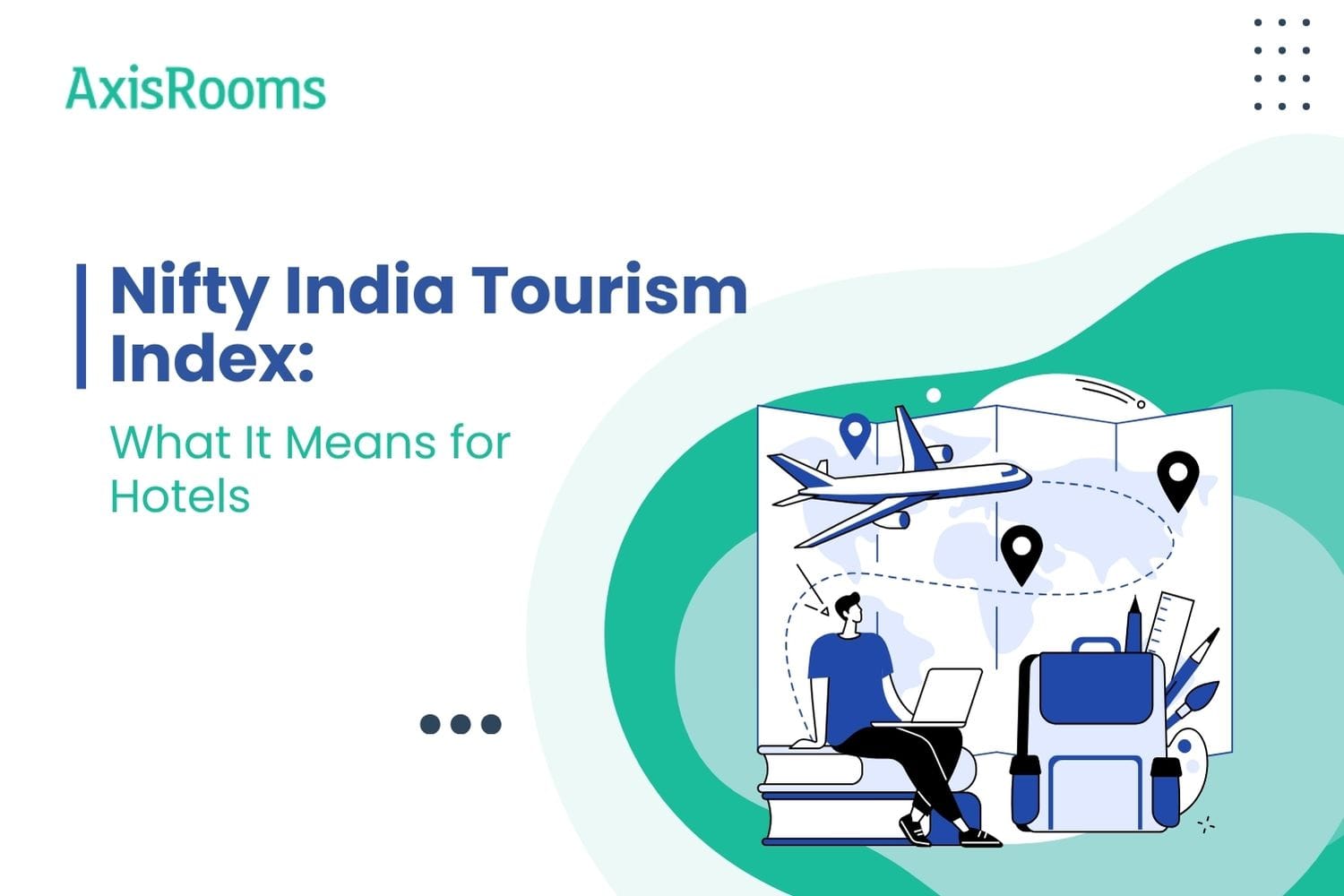Did you know that tourism contributes nearly 9% to India’s GDP and is one of the fastest-growing sectors? Surprisingly, until now, there was no detached tool to gauge this significant sector of India. Here comes a breakthrough, the Nifty Tourism Index, that provides data to analyze tourism patterns, trends, company growth and investments.
For hotel owners, investors, and tourism operators, this index is more than just a financial tracker; it's a roadmap to identify opportunities, refine strategies, and stay competitive. In this blog, we’ll break down the Nifty Tourism Index, its benefits, challenges, and how it’s set to shape the future of India’s hospitality industry.
What Exactly is the Nifty Tourism Index?
The Nifty Tourism Index is a stock market index that captures the status of the companies that are part of India’s tourism value chain. This includes major contributors such as hotels, airlines, tour operators, and other service providers. It serves as a tourism sector performance metric.
Key Metrics and Composition
It covers the growth, as well as capitalization and performance of the stocks of the tourism enterprises.
It covers Taj Hotels, Indigo Airlines, and IRCTC, who are the major players in the sector.
Why It Matters
Just like any other index, this one too plays a vital role in the tourism industry’s movement. It helps stakeholders and investors determine market conditions, performance indexes, and growth potential. It further enhances the credibility of the sector and attracts local and foreign investors.
Why Every Hotelier Needs to Take This Seriously
The Nifty Tourism Index is more than just a compilation of major companies; it serves as a valuable resource for hotel owners, managers, and investors. It provides insights into market trends, competitor actions, and potential opportunities. Here’s how it can be beneficial:
Compare Your Hotel to Others
What It Does: The index allows you to evaluate your hotel’s performance against others in the industry.
Why It Matters: Imagine discovering the reasons behind a rival hotel’s success, even during slow periods. The index highlights trends in revenue, guest preferences, and booking rates, which can guide you in making informed decisions for your own establishment.
Example: For instance, if a hotel in the index consistently attracts guests during the offseason, you can analyze its pricing or marketing tactics and implement similar strategies to draw visitors throughout the year.
Attract More Investors
Visibility and Trust: Hotels featured in the index gain attention from investors, as it serves as evidence of their reliability and profitability. This increased visibility can facilitate access to funding for expansion or renovations.
Study Insight: A 2021 report by McKinsey highlighted that indexed companies in tourism saw a 15% increase in institutional investments compared to non-indexed ones.
Growth Insights
Data-Driven Decisions: The index identifies demand trends, infrastructure gaps, and emerging markets.
Regional Focus: Offers insights into which areas—like Tier-II cities or eco-tourism hubs—are gaining traction.
Example: Data may show increased demand for luxury stays in Rajasthan or adventure tourism in Himachal Pradesh, guiding investment decisions.
How the Nifty Tourism Index Impacts Different Hospitality Stakeholders
The Nifty Tourism Index isn’t just for investors. It offers actionable insights for hotel owners, tourism operators, and other stakeholders.

1. Hotel Owners
- Helps track performance metrics and refine strategies.
- Provides insights into pricing strategies, guest preferences, and operational efficiency.
- Example: If occupancy rates for listed hotels spike during festive seasons, smaller hotels can adjust their marketing to capture similar demand.
2. Investors
- Offers a clear picture of market trends and profitability.
- Identifies high-growth segments, making investment decisions more informed.
- Study Insight: Research by Deloitte found that indices increase investor confidence by providing transparent and reliable data.
3. Tourism Operators
- Encourages collaboration with hotels, airlines, and transport providers.
- Offers data on seasonal demands, helping operators plan packages effectively.
The Challenges: What Could Hold Back the Nifty Tourism Index?
While the Nifty Tourism Index holds immense potential, it’s not without its challenges:
Early Adoption Hurdles
- Many businesses are unfamiliar with how to use the index for strategic decisions.
- Smaller players may struggle to align their operations with the benchmarks set by larger, listed companies.
External Risks
- Geopolitical events, like border tensions or visa restrictions, can impact tourism demand and, in turn, the index’s performance.
- Example: The pandemic drastically reduced travel and tourism revenue worldwide, showing how external factors can disrupt even robust systems.
Case Studies and Real-Life Examples
Global Success Stories
- Dow Jones Tourism Index (U.S.): Helped highlight the growth of companies like Marriott and Delta Airlines, driving investments into the sector.
- FTSE Travel & Leisure Index (UK): Played a pivotal role in attracting international funds to the UK’s tourism businesses, especially during the lead-up to the Olympics.
Hypothetical Indian Example
- A mid-scale hotel chain in Goa could use the index to track increasing demand for wellness tourism, prompting it to introduce spa packages and yoga retreats.
The Road Ahead: What’s Next for India’s Tourism Industry?
The Nifty Tourism Index is just the beginning. Its potential to shape India’s hospitality landscape is immense.
Sector Diversification
- Likely to include emerging segments like medical tourism, adventure tourism, and eco-tourism.
- Example: The rise of Ayurveda retreats in Kerala could become a focal point for investments.
Infrastructure Development
- By identifying demand gaps, the index could drive better infrastructure in underdeveloped areas.
- Example: Improved connectivity and luxury accommodations in Tier-II cities like Jaipur or Coorg.
Opportunities for Small Players
- Small and mid-scale hotels can use insights to compete with larger chains by focusing on niche markets or unique offerings.
How to Use the Nifty Tourism Index for Growth
Here’s how businesses can use the Nifty Tourism Index for strategic growth:
- Track Trends Regularly
- Follow index updates to stay ahead of market shifts.
- Use the data to identify opportunities in pricing, infrastructure, or guest preferences.
- Collaborate Within the Sector
- Partner with other stakeholders, like airlines or tour operators, to create bundled offerings.
- Example: A hotel can partner with a listed airline to offer discounts for package bookings.
- Invest Smartly
- Focus on high-growth regions or services highlighted by the index.
How AxisRooms Helps Hotels Stay Competitive in the Nifty Tourism Index
With data and technology driving tourism decisions, tools like AxisRooms help hotels make real-time, strategic moves in a competitive industry.
AxisRooms Revenue Management System (RMS) - Aligning Your Pricing with Market Trends
- The Nifty Tourism Index tracks market fluctuations—but how do hotels react to it?
- AxisRooms’ RMS helps hotels adjust pricing dynamically, ensuring they remain competitive without underpricing.
- The system analyzes historical data, competitor pricing, and demand trends to suggest the best rates.
Example: If the index shows an upcoming peak season for beach tourism in Goa, hotels using AxisRooms RMS can increase rates strategically while maintaining affordability.
AxisRooms Channel Manager - Expanding Market Reach & Visibility
- AxisRooms Channel Manager allows hotels to distribute rooms across multiple OTAs (Online Travel Agencies).
- Ensures that pricing remains consistent across platforms, avoiding rate disparities.
Example: If an indexed hotel sees increased demand in a particular city, using AxisRooms Channel Manager helps ensure that rooms are listed at the right price, across all major booking channels, maximizing revenue.
Conclusion
The Nifty Tourism Index will transform the entire hospitality landscape in India. It empowers investors, hotel owners, and other tourism players to make informed decisions by ensuring a level of transparency, monitoring performance, and spotting growth targets.
For hoteliers, new or established, thanks to the index, being competitive in a fast-paced market is practical. It will assist them in ensuring profitability while also focusing on long-term success by fusing data-oriented strategies with the guest experience.


